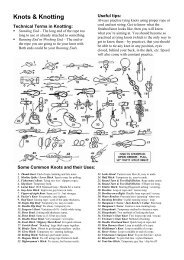Becoming Self-Sufficient for Six Months - Blog by Survival-Goods.com
Becoming Self-Sufficient for Six Months - Blog by Survival-Goods.com
Becoming Self-Sufficient for Six Months - Blog by Survival-Goods.com
Create successful ePaper yourself
Turn your PDF publications into a flip-book with our unique Google optimized e-Paper software.
your water heater, and a few more gallons if you drain down your pipes.<br />
♦ Save your disposable soft drink and water bottles <strong>for</strong> future storage of drinking<br />
water. Allow them to dry and then store them in new trash bags. When the pandemic<br />
is announced, sanitize these bottles and caps <strong>by</strong> immersing them in a solution<br />
of 1 tablespoon of chlorine bleach per gallon of water <strong>for</strong> two minutes. Then,<br />
fill them with water from your tap. Add 4 drops of unscented chlorine bleach per<br />
gallon as a preservative and this water will be safe to drink <strong>for</strong> at least one year.<br />
♦ Save your plastic milk jugs, too, but do not plan to store drinking water in them.<br />
Due to the milk protein residues, you can never really get them clean enough. Instead,<br />
use them to store water <strong>for</strong> washing or flushing only. Because of the protein<br />
residues, you will need to add 8 drops (¼ teaspoon) of unscented bleach per<br />
gallon of tap water. Milk jugs will biodegrade, so keep them out of the sunlight.<br />
♦ Water that you collect from any alternate source <strong>for</strong> washing your body or clothes<br />
should be treated with 8 drops of bleach per gallon, however, this water should<br />
still be considered potentially hazardous, even with the addition of bleach. The<br />
large volume that you require <strong>for</strong> washing makes filtration impractical, so you<br />
must not allow this water to <strong>com</strong>e into contact with your face or any broken skin<br />
(remember cryptosporidium and giardia lamblia). If you need to wash your face or<br />
broken skin, boil this water first, or use drinking water instead.<br />
♦ All cooking water that you collect from alternate sources should<br />
be filtered and<br />
boiled. If it reaches a full boil during cooking, you will not have to add bleach. If<br />
you do not have a proper water filter, you can remove most of the sediments from<br />
collected water <strong>by</strong> pouring it through a few coffee filters or layers of cloth.<br />
♦ Yes, you can boil water from just about any source and make it safe <strong>for</strong> drinking<br />
in<br />
a single step, but this process uses an awful lot of fuel.<br />
♦ Consider the purchase of a high quality, portable, water<br />
filtration device, such as<br />
the Katadyn Gravidyn, <strong>for</strong> treating the water you collect. Be sure that the device<br />
you purchase is easy to use <strong>by</strong> everyone and will meet the needs of your entire<br />
household <strong>for</strong> at least one full year. (The Gravidyn produces one gallon of 0.2 micron<br />
filtered water per hour, has no moving parts, requires no power, does not<br />
have to be attended, is good <strong>for</strong> 10,000 gallons, and costs about $160 at REI.)<br />
♦ If you do not have enough water <strong>for</strong> properly washing pots and pans, wipe them<br />
clean with a paper towel, then sanitize them <strong>by</strong> soaking them in bleach water <strong>for</strong><br />
two minutes. 1 tablespoon of bleach per gallon is adequate <strong>for</strong> kitchen use.<br />
♦ If your domestic water supply is ever interrupted, you can conserve water <strong>by</strong> using<br />
disposable cups, plates, and utensils.<br />
♦ If you have a well and a generator, you<br />
should be able to draw water at a rate of 4<br />
or 5 gallons per minute. If you allow <strong>for</strong> a few minutes of fuel consumption each<br />
time you warm up the engine, you should be able to draw 50 gallons of water <strong>for</strong><br />
every ¼ gallon of gasoline your generator consumes. With a fuel supply of only 15<br />
gallons, you could operate a 5,000 watt generator long enough to pump 50 gallons<br />
of water per day, every day, <strong>for</strong> 2 full months. 90 gallons would last a year.<br />
♦ An inexpensive alternative to a private well is a manual water pump <strong>for</strong> a shallow<br />
well. Although these “jerk-water” pumps can only draw from about 25 feet down,<br />
they are fairly cheap to purchase from such outfits as Northern Tools. Of course,<br />
you may need someone to help you install it and, since this type of well is not very<br />
deep, you must filter and purify the water. Apart from that, you do need to have<br />
shallow groundwater in your region, so this solution is not <strong>for</strong> everyone.<br />
<strong>Be<strong>com</strong>ing</strong> <strong>Self</strong>-<strong>Sufficient</strong> <strong>for</strong> <strong>Six</strong> <strong>Months</strong> page 10
















